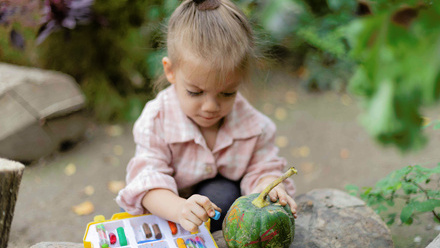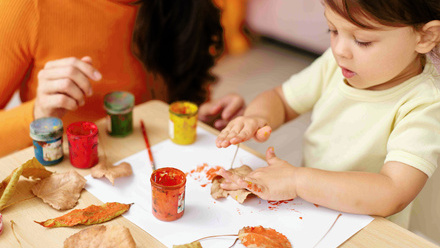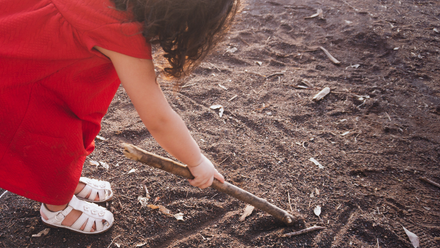How to support risky play with toddlers
Testing boundaries, having a go, learning how to get back up when we fall down – it’s all part of flexing our limits and figuring out how far we can go before extending our comfort zone. It’s a huge part of learning about ourselves and our place in the world, which is why working to establish some of these notions in early childhood is so important for thinking about confident progression throughout youth and beyond.
Risky play is all about providing the environment and means for children to test these limits in a safe and supportive way. Knowing of the presence of a ‘safety net,’ a familiar person, doesn’t eradicate any sense of danger or anxiety, but helps to promote the positive feelings of curiosity and adventure.
We’ve looked at some of the benefits of risky play, but what can we do to support it? This learning workout will think through some of the ways you can help to build and extend elements of risky play already established in your setting by thinking about some of the smaller changes you might make to your approach, maximising the impact of risk within your setting.
What is risky play?
Play is a difficult concept to define because it trickles into every aspect of life and is a personal experience for everyone who engages with playful behaviour. The Playwork Principles define play as:
- All children and young people need to play. The impulse to play is innate. Play is a biological, psychological and social necessity, and is fundamental to the healthy development and wellbeing of individuals and communities.
- Play is a process that is freely chosen, personally directed and intrinsically motivated. That is, children and young people determine and control the content and intent of their play, by following their own instincts, ideas and interests, in their own way for their own reasons.
Have a look at the definition highlighted above.
How far do you agree? Is there anything that you would add, or change?
Research is constantly growing in support of the integral role that play has in facilitating development throughout life, but especially so in one’s early years. When life is ‘play-filled’, children are motivated to learn and foster a range of skills, recognise others’ feelings as well as their own, explore new possibilities and respond to stressful situations with heightened resilience. But when children are deprived of playful experiences, they are more likely to experience fear and resistance, lack motivation and fail to recognise their own needs and those of others. experience fear and resistance, lack motivation and fail to recognise their own needs and those of others.
Play deprivation has serious consequences that last a lifetime. Early education and care professionals hold the power and a special responsibility to ensure that children are interacting in a multitude of playful environments that maintain learning opportunities across all areas of development, with risky play being just one aspect of this kaleidoscope approach.
Supporting the risky stuff
Allow them to get it wrong
Making mistakes is one of the best ways to learn! As with all elements of playful learning, making errors and evaluating new avenues allows children to think carefully about their decision-making and understand that not everything works the first time. When thinking about risky play, it can be tricky to think about ‘getting it wrong’ aside from hurting oneself, but part of the risk involves learning about consequences in a way that supports understanding limits and boundaries. It may look like allowing a child to use scissors to cut something within a project that they can’t undo afterwards, making the choice to do something irretrievable is a risk and sometimes a mistake. Learning about risk and its role in potential upset can help children to understand the importance of thinking through decisions and acknowledging potential consequences before acting.
Make things more difficult
Risky play isn’t always about challenge, but making things trickier to extend problem-solving skills and creative thinking is a fun way to expand upon the learning opportunities within a risky environment, challenging our perceptions and confidence to show that, sometimes, we just need to believe we can do it! This might involve physical activities where we can make things higher, wider or deeper to test our capacity and develop a practical understanding of spatial awareness and reasoning. Children grow fast – constantly observe children’s abilities to formatively assess and change risky environments to provide a constantly challenging and stimulating space for risk.
Let them lead
Taking risks is intrinsic to decision-making and the two go hand in hand with play. Child-led play is at the heart of quality practice with young children but it can be difficult to ‘let go’ as a professional supervising play when there are elements of risk involved. Granting children the space and capacity to make their own safe choices – even choosing between two options – promotes their sense of autonomy and inquisitiveness but also creates a sense of belonging and value to play, where the choices are considered with friends, or an adult, to share thought processes and encourage valuable communication too.
Keep it consistent
Another advantage to risky play is the ways in which it encourages children to think about limits and understand boundaries. Overprotection and restriction on children’s experiences can have a long-lasting impact on various elements of development so, whilst we need to ensure safety at all times, risky play supports children to negotiate challenge and manage potential risks sensibly. But, for these boundaries to be understood and respected, they need to be implemented with consistency. Communicating with all grown-ups about the limits and values of risky play helps to establish a concrete approach to where risks can be considered and what to do when they exceed these boundaries. Relaying this approach to families can also provide consistency across different areas of a child’s life, establishing what is ’okay and safe’ to do in different contexts.
Stay calm yourself
Watching children take risks and make mistakes can be a challenge for those of us who can anticipate failures and know of the likely consequences. As long as children and supervised and safe, professionals should try to mask their hesitancy to avoid imposing apprehension onto the children involved in the play. Overprotection in this respect can contribute to a child’s lacking confidence in ability or inclination to take further risks in the future so we need to be a loud voice championing and instilling their beliefs to thrive in a risky environment as much as a safe one.
Conclusion
Risky play takes shape in a variety of ways and has a different meaning for different people. Some children might thrive with heights and elevation whereas, for others, climbing above the ground level can be a terrifying prospect.
Think about the perspectives of the individuals involved when planning risky activity and ensure someone is always there to stop any element of risk at any time. Whether it is to anticipate an injury or simply remove a child from the situation causing them to feel unsafe, ensuring everyone’s wellbeing and safety is paramount to the work we do with young children. Make sure all risky play provisions are in line with setting policy and appropriate assessments have been undertaken.






